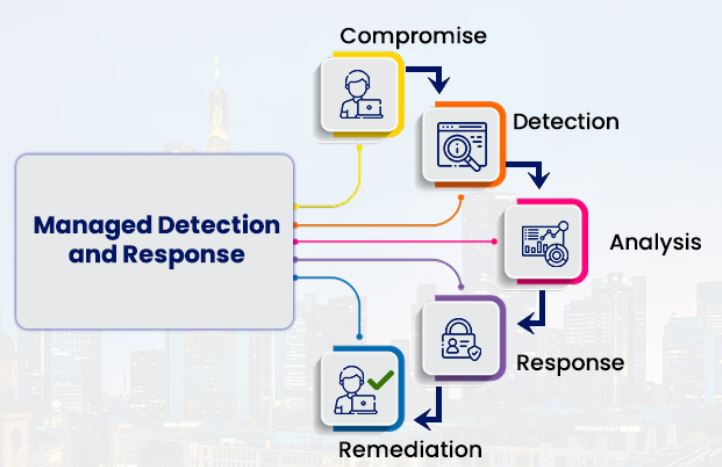
MDR (Managed Detection and Response)
In its simplest form, the definition of the concept of MDR (Managed Detection and Response) contributes to the solution to the relevant incident with the ability to quickly detect malware, potential attacker activities and intrusions in a network. MDR services directly contribute to cyber security within the organization as they increase visibility within the established network. In addition to these features, it is a cyber security service based on machine learning.
To mention its most basic benefits, it helps to quickly identify and limit the impact of possible threats without the need for additional personnel within the organization.
How MDR Works
MDR generally provides planning and implementation of basic network and endpoint security, including:
1-) Deploy: It is to cover the entire endpoint network of the institution in reducing threats as quickly and comprehensively as possible.
2-) Detect: Using the EDR tool and threat intelligence data, it provides continuous monitoring of the corporate network and endpoints and provides the opportunity to detect possible threats.
3-) Triage (Priority): It enables prioritization and verification of detected threats based on the most likely impacts of an incident.
4-) Respond and Remediate: Informing the security team to take recommended actions, eliminate any significant threats that may be encountered, and set up automatic responses to restore the system.
5-) Report: It provides a detailed report for each incident (threat status, detection and resolution).
What are the advantages?
– 24/7 Monitoring: MDR services provide 24-hour monitoring and protection for client networks. Thanks to this feature, quick action can be taken against a cyber attack that may occur 24/7.
– Proactive Approach: MDR services minimize the possibility of events that pose a risk in terms of cyber security by detecting and closing security vulnerabilities before they are used by the attacker.
– Visibility: MDR services offer broad and deep visibility (monitoring) over client networks. As a result of this feature, it provides the opportunity to develop and use threat intelligence against specific threats in incident response processes.
– Vulnerability Management: MDR services help identify vulnerable systems and make patches and updates on these systems.
– Compatibility: MDR services are structured to meet the requirements of legislation, laws and regulations. It also provides a conclusion and report to the analyst at the end of the day.
Why is MDR Service Needed?
It can basically be explained under a few headings:
1-) Advanced Threat (APT) Detection: It has an instant reaction function that uses advanced behavioral and high-tech endpoint analytics and retrieved statistics to hunt down unknown threats before they can take over the enterprise database and network. Essentially, it has the ability to automatically detect threats that can evade antivirus and firewall software using artificial intelligence.
2-) Comprehensive Threat Research and Verification: Rather than searching for threats, MDR services can also perform extensive research and verification. One of the underlying reasons for this is to comprehensively evaluate whether the incoming warning is real or not and to prevent false alarms (False Positive situations) that will waste time and manpower.
3-) Integrated Incident Response: In case of any violation, MDR services prevent the threat as quickly as possible before it causes damage to the institution and ensures that it is monitored and managed by security personnel. In other words, it provides support to authorized persons in closing the threats that occur.
What are the differences between MDR and MSSP?
Although MSSP (Managed Security Services Provider) has similarities with MDR, it differs in terms of technology and relationship.
– MSSP services are proactive, focusing on threats, meaning they are designed to focus on vulnerabilities. MDR services, on the other hand, are designed in a structure that has the ability to detect, respond and focus on threat hunting rather than monitoring a security alert.
– Both manage the firewall, but MDR services are one step ahead of MSSP in situations such as threat analysis, research and forensic analysis.
– While MDR services offer 24/7 threat detection and intervention, this is the case for some types of MSSP.
What are the differences between EDR and MDR?
– EDR focuses on a specific endpoint and provides protection. MDR is the organization's entire IT
Provides security monitoring and management in the environment.
– If considered in terms of the problems they focus on, EDR provides the security visibility and management on systems needed for endpoints on institutions. MDR, on the other hand, offers solutions to the skill gaps in security management faced by the organization.
Resources Used:
https://www.cybereason.com/fundamentals/what-is-mdr
https://www.stealthlabs.com/blog/managed-detection-and-response-mdr-overview-and-importance/
https://www.trellix.com/en-us/security-awareness/endpoint/what-is-managed-detection-response.html